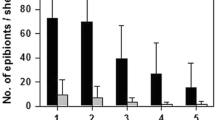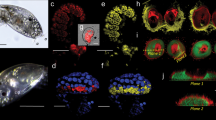Abstract
Barnacle settlement inhibitors and inducers are present in the gorgonianLeptogorgia virgulata and the pennatulaceanRenilla reniformis. The inhibitors are low-molecular-weight compounds (<20,000 daltons) that were detected in soft tissue homogenates and dialysates of homogenate and in ambient “gorgonian water.” Settlement was almost completely inhibited at a dialysate concentration of 1.0 g wet weight equivalents/liter. The inhibitors probably function in chemical defense against predation and fouling, and could prove useful in ship fouling control. The settlement inducers are high-molecular-weight substances (>20,000 daltons) that adsorb to surfaces.
Similar content being viewed by others
References
Bakus, G.J. 1974. Toxicity in holothurians: A geographical pattern.Biotropica 6:229–236.
Burkholder, P.R. 1973. The ecology of marine antibiotics and coral reefs, pp. 117–182,in O. Jones and R. Endean (eds.). Biology and Geology of Coral Reefs, Vol. 2. Academic Press, New York. 480 pp.
Burkholder, P.R., andBurkholder, L.M. 1958. Antimicrobial activity of horny corals.Science 127:1174.
Ciereszko, L.S. 1962. Chemistry of coelenterates. III. Occurrence of antimicrobial terpenoid compounds in the zooxanthellae of alcyonarians.Trans. N. Y. Acad. Sci. Ser. 2 24:502–503.
Ciereszko, L.S., andKarns, T.K.B. 1973. Comparative biochemistry of coral reef coelenterates, pp. 183–203,in O. Jones and R. Endean (eds.). Biology and Geology of Coral Reefs, Vol. 2. Academic Press, New York. 480 pp.
Crisp, D.J. 1974. Factors influencing the settlement of marine invertebrate larvae, pp. 177–265,in P.T. Grant and A.M. Mackie (eds.). Chemoreception in Marine Organisms. Academic Press, New York. 295 pp.
Crisp, D.J. 1976. Settlement responses in marine organisms, pp. 83–124,in R.C. Newell (ed.). Adaptation to Environment: Essays on the Physiology of Marine Animals. Butterworths, London. 539 pp.
Crisp, D.J., andMeadows, P.S. 1962. The chemical basis of gregariousness in cirripedes.Proc. R. Soc. London Ser. B 156:500–520.
Crisp, D.J., andMeadows, P.S. 1963. Adsorbed layers: The stimulus to settlement in barnacles.Proc. R. Soc. London Ser. B 158:364–387.
D'agostino, A., andSheridan, P.O. 1969.Balanus eburneus, factors affecting metamorphosis and larval axenization.Am. Zool. 9:618.
Fenical, W. 1978. Diterpenoids, pp. 173–245,in P.J. Scheuer (ed.). Marine Natural Products: Chemical and Biological Perspectives, Vol. 2. Academic Press, New York. 392 pp.
Fenical, W., Okuda, R.K., Bandurraga, M.M., Culver, P., andJacobs, R.S. 1981. Lophotoxin: A novel neuromuscular toxin from Pacific sea whips of the genusLophogoria.Science 212:1512–1514.
Good, M.L., Kulkarni, V.H., Monaghan, C.P., andHoffman, J.F. 1979. Antifouling marine coatings and their long-term environmental impact, pp. 19–35,in J.W. Day, D.D. Culley, R.E. Turner, and A.J. Mumphrey (eds.). Proc. Third Coastal Marsh and Estuary Management Symp., Louisiana State University, Baton Rouge.
Guillard, R.F.L. 1975. Culture of phytoplankton for feeding marine invertebrates, pp. 29–60,in W.L. Smith and M.H. Chanley (eds.). Culture of Marine Invertebrate Animals. Plenum Press, New York. 338 pp.
Hadfield, M.G., andCiereszko, L.S. 1978. Action of cembranolides derived from octocorals on larvae of the nudibranchPhestilla sibogae, pp. 145–150,in P.N. Kaul and C.J. Sindermann (eds.). Drugs and Food from the Sea. University of Oklahoma, Norman. 448 pp.
Hoare, R., andHiscock, K. 1974. An ecological survey of the rocky coast adjacent to a bromine extraction works.Estuarine Coastal Mar. Sci. 2:329–348.
Kato, T., Kumanireng, A.S., Ichinose, I., Kitahara, Y., Kakinuma, Y., Nishihira, M., andKato, M. 1975. Active components ofSargassum tortile effecting the settlement of swimming larvae ofCoryne Uchidai.Experientia 31:433–434.
Kittredge, J.S., Takahashi, F.T., Lindsey, J., andLasker, R. 1974. Chemical signals in the sea: Marine allelochemics and evolution.Fish. Bull. 72:1–11.
Knight-Jones, E.W. 1953. Laboratory experiments on gregariousness during setting inBalanus balanoides and other barnacles.J. Exp. Biol. 30:584–598.
Knight-Jones, E.W., andStevenson, J.P. 1950. Gregariousness during settlement in the barnacleElminius modestus Darwin.J. Mar. Biol. Assoc. U.K. 29:281–297.
Larman, V.N., andGabbott, P.A. 1975. Settlement of cyprid larvae ofBalanus balanoids andElminius modestus induced by extracts of adult barnacles and other marine animals.J. Mar. Biol. Assoc. U.K. 55:183–190.
Lewis, C.A. 1978. A review of substratum selection in free-living and symbiotic cirripeds, pp. 207–218,in F.S. Chia and M.E. Rice (eds.). Settlement and Metamorphosis of Marine Invertebrate Larvae. Elsevier, New York. 290 pp.
Morse, D.E., Hooker, N., Duncan, H., andJensen, L. 1979. γ-aminobutyric acid, a neurotransmitter, induces planktonic abalone larvae to settle and begin metamorphoisis.Science 204:407–410.
Patton, W.K. 1972. Studies on the animal symbionts of the gorgonian coral,Leptogorgia virgulata (Lamarck).Bull. Mar. Sci. 22:419–431.
Perkins, D.L., andCiereszko, L.S. 1973. The environmental toxicity of crassin acetate usingTetrahymena pyriformis as a model.Hydrobiologia 42:77–84.
Scheltema, R.S. 1974. Biological interactions determining larval settlement of marine invertebrates.Thalassia Jugosl. 10:263–296.
Sieburth, J.McN., andConover, J.T. 1965.Sargassum tannin, an antibiotic which retards fouling.Nature 208:52–53.
Sondheimer, E., andSimeone, J.B. 1970. Chemical Ecology. Academic Press, New York. 336 pp. Tursch, B. 1976. Some recent developments in the chemistry of alcyonaceans.Pure Appl. Chem. 48:1–6.
Tursch, B., Braekman, J.C., Daloze, D., andKaisin, M. 1978. Terpenoids from coelenterates, pp. 247–296,in P.J. Scheuer (ed.). Marine Natural Products: Chemical and Biological Perspectives, Vol. 2. Academic Press, New York. 392 pp.
Weinheimer, A.J., andMatson, J.A. 1975. Crassin acetate, the principal antineoplastic agent in four gorgonians of thePseudoplexaura genus.Lloydia 38:378–382.
Whittaker, R.H., andFeeny, P.P. 1971. Allelochemics: Chemical interactions between species.Science 171:757–770.
Author information
Authors and Affiliations
Rights and permissions
About this article
Cite this article
Standing, J.D., Hooper, I.R. & Costlow, J.D. Inhibition and induction of barnacle settlement by natural products present in octocorals. J Chem Ecol 10, 823–834 (1984). https://doi.org/10.1007/BF00987966
Received:
Revised:
Issue Date:
DOI: https://doi.org/10.1007/BF00987966




